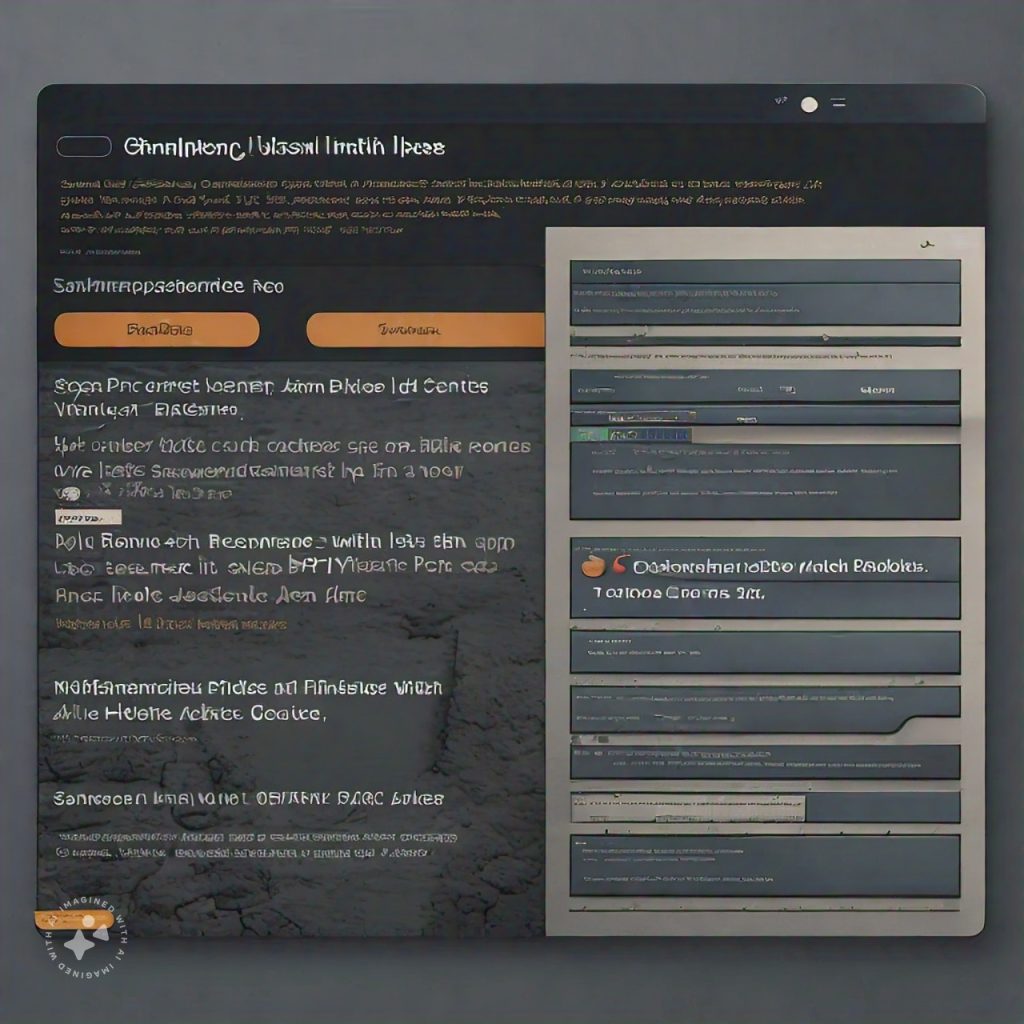
In the ever-evolving world of digital design, creating a user interface (UI) and user experience (UX) that captivates and engages users is both an art and a science. But let’s be honest—getting it right is no easy feat. You’ve likely poured countless hours into crafting the perfect design, only to realize that it just doesn’t resonate with your audience. Or worse, users are bouncing off your site faster than you can say “back to the drawing board.” But don’t worry, you’re not alone. Even the most seasoned designers make mistakes. The good news? These pitfalls are entirely avoidable with a little foresight and a lot of empathy for the user.
You land on a beautifully designed website, but within minutes, you’re lost in a maze of confusing navigation, struggling to read the text because of low contrast, and feeling frustrated by slow loading times. Sounds like a nightmare, right? Unfortunately, it’s an all-too-common scenario. These are just a few examples of UI/UX design mistakes that can derail an otherwise promising project. The impact? Users leave, conversions drop, it affects your google ranking and your carefully crafted design ends up as just another statistic in the “why users abandon sites” category.
You can learn from these common mistakes and ensure your designs not only look good but also deliver a seamless, enjoyable experience for your users. Let’s talk about the ten most common UI/UX design mistakes , detailing why they are mistakes, and more importantly, how you can avoid them to create a product that truly shines.
1. Overcomplicating the Design
We’ve all seen designs that are so full of bells and whistles that users have no idea where to start. I understand the urge to have a bit of every design style in your work so you could excite your audience but although fancy animations, excessive menus, or overly complex layouts might look cool,they often overwhelm the user, leading to frustration and abandonment.
Why it’s a mistake: The allure of adding more features and visual elements can be strong, but it’s a classic case of “more is not always better.” A cluttered design can confuse users, making it difficult for them to find what they need. When users have to work too hard to understand your interface, they’re likely to leave and never return. Simplicity is key in UI/UX design. The goal is to create a seamless experience where users can easily navigate and accomplish their tasks without unnecessary distractions.
How to avoid it: Focus on clarity and simplicity. Every element on the page should serve a purpose. Start by identifying the core actions you want your users to take and design around those. Ask yourself, “Does this feature add value?” If the answer is no, it’s probably better to leave it out. Use whitespace effectively to give your design room to breathe, and prioritize functionality over form. Remember, a simple, intuitive design is often more powerful than one packed with unnecessary features.
2. Ignoring User Feedback
It’s easy to get attached to your design, but if your users are struggling, it’s time to listen. Ignoring feedback is one of the biggest mistakes designers can make. After all, your users are the ones interacting with your design daily—they know best what works and what doesn’t.
Why it’s a mistake: Users are the best judge of your design’s effectiveness. If you’re not considering their feedback, you’re missing out on valuable insights that could dramatically improve the user experience. When you disregard user feedback, you risk alienating your audience and creating a product that fails to meet their needs.
How to avoid it: Regularly seek out and act on user feedback. Whether it’s through surveys, usability tests, or direct communication, make sure you’re continually refining your design based on what your users are telling you. Create a feedback loop where users feel heard and valued. By incorporating their suggestions, you not only improve your design but also build trust and loyalty with your audience. Remember, design is never finished—it’s an ongoing process that evolves with your users’ needs.
3. Neglecting Mobile Users

With so many users accessing websites and apps on their phones, failing to design for mobile is a huge oversight. A site that looks great on desktop but is impossible to navigate on a phone is a deal-breaker in today’s mobile-first world.
Why it’s a mistake: Mobile traffic has overtaken desktop traffic, meaning if your design isn’t mobile-friendly, you’re losing a significant portion of your audience. A poor mobile experience can lead to high bounce rates and low engagement, ultimately hurting your brand’s reputation and bottom line.
How to avoid it: Adopt a mobile-first design approach. This doesn’t mean neglecting desktop users, but rather ensuring that your design scales smoothly across all devices. Prioritize responsive design techniques that adapt to different screen sizes and orientations. Test your designs on various mobile devices to ensure a consistent and user-friendly experience. Additionally, streamline content and features for mobile users, focusing on what’s most important to them. By doing so, you create a more accessible and enjoyable experience for your entire audience, regardless of how they choose to interact with your product.
4. Poor Navigation Structure
If users can’t find what they’re looking for quickly and easily, they’re going to get frustrated. A confusing or cluttered navigation menu can turn users away faster than you can say “back button.”
Why it’s a mistake: Good navigation is the backbone of a positive user experience. Without it, users will struggle to move through your site or app efficiently, leading to frustration and abandonment. A poorly structured navigation system can make even the best content inaccessible, negating all your hard work.
How to avoid it: Keep navigation simple and intuitive. Use clear, descriptive labels that accurately represent the content or functionality behind them. Limit the number of menu items to avoid overwhelming users. Consider using familiar patterns that users are already comfortable with, such as a top navigation bar or a hamburger menu for mobile devices. Additionally, organize your content in a logical hierarchy that guides users from general to specific information. By making navigation a priority, you ensure that users can easily find what they need, enhancing their overall experience.
5. Inconsistent Design Elements

Consistency in design isn’t just about making things look pretty; it’s about creating a coherent experience. If buttons, fonts, and colors vary wildly from page to page, users can become confused and disoriented.
Why it’s a mistake: Inconsistent design can make your interface feel disjointed and unprofessional. It can also disrupt the user’s flow, leading to frustration and disengagement. Users expect a certain level of predictability in design—when this is lacking, it can create a jarring experience that undermines the trust and usability of your product.
How to avoid it: Stick to a design system or style guide that outlines your color scheme, typography, and UI elements. Ensure that every part of your design aligns with this guide, creating a cohesive and unified experience. Use consistent spacing, button styles, and interactions across your entire site or app. Additionally, test your design with real users to ensure that the consistency you’ve built actually enhances the user experience. By maintaining consistency, you create a more intuitive and enjoyable experience that keeps users engaged.
6. Lack of Accessibility Considerations
Designing for accessibility means making sure that everyone, including people with disabilities, can use your site or app effectively. Overlooking this aspect is a major mistake that not only limits your audience but also reflects poorly on your brand’s inclusivity.
Why it’s a mistake: Not only does ignoring accessibility limit your audience, but it can also lead to legal issues in some jurisdictions. Plus, it’s simply the right thing to do. Accessibility ensures that your design can be enjoyed by everyone, regardless of their abilities. When you fail to consider accessibility, you’re excluding a significant portion of potential users.
How to avoid it: Familiarize yourself with accessibility guidelines, such as the Web Content Accessibility Guidelines (WCAG). Use tools to check your design’s accessibility, and make sure to include features like alt text for images, keyboard navigation, and sufficient color contrast. Additionally, design with accessibility in mind from the start, rather than treating it as an afterthought. This includes choosing accessible fonts, designing for screen readers, and ensuring that interactive elements are easy to use for all users. By prioritizing accessibility, you not only expand your audience but also demonstrate a commitment to inclusivity and user-centered design.
7. Using Low-Contrast Text

Low-contrast text might look sleek and modern, but it’s often hard to read, especially for users with visual impairments or those in bright environments. It’s a subtle mistake that can have a big impact on readability and user engagement.
Why it’s a mistake: If users have to strain to read your content, they’re likely to get frustrated and leave. Readability is a crucial part of the user experience, and low-contrast text can significantly hinder it. This mistake can alienate users, particularly those with visual impairments, reducing the overall accessibility and inclusivity of your design.
How to avoid it: Ensure there’s enough contrast between your text and background colors. Tools like Contrast Checker can help you test and adjust your color combinations to meet accessibility standards. Additionally, consider the context in which your design will be viewed—bright environments, for example, may require higher contrast for optimal readability. By prioritizing readability through appropriate contrast, you create a more inclusive and user-friendly experience that keeps users engaged and coming back for more.
8. Too Much Text

It’s tempting to cram as much information as possible onto each page, but too much text can overwhelm users and make your design feel cluttered. In today’s fast-paced digital world, users are looking for quick, easily digestible information—not long blocks of text.
Why it’s a mistake: Users don’t want to read a novel to find the information they need
. Long blocks of text can lead to cognitive overload, causing users to disengage and miss key messages. A cluttered design with excessive text can also slow down the user’s journey, leading to frustration and abandonment.
How to avoid it: Break up text into manageable chunks. Use headings, bullet points, and short paragraphs to make your content more digestible. Remember, white space is your friend—it helps create a clean, readable design. Additionally, focus on the key points and eliminate any unnecessary information. By presenting your content in a clear, concise manner, you enhance the user experience and keep users engaged. Consider using visuals, such as images or infographics, to complement your text and convey information more effectively.
9. Overlooking Loading Time
In a world where speed is everything, a slow-loading site or app can drive users away before they even get a chance to see your design. Users expect fast, seamless experiences, and if your design doesn’t deliver, they’ll move on to something quicker.
Why it’s a mistake: Users have little patience for slow-loading sites, especially in today’s fast-paced digital landscape. A slow site can lead to high bounce rates, lower user engagement, and reduced conversions. It can also negatively impact your search engine rankings, making it harder for users to find your site in the first place.
How to avoid it: Optimize images, use efficient code, and consider a content delivery network (CDN) to speed up your site. Regularly test your design’s performance and address any bottlenecks that might be slowing things down. Additionally, consider lazy loading for images and other content that isn’t immediately visible to speed up the initial load time. By prioritizing performance, you create a faster, more enjoyable experience that keeps users engaged and coming back for more.
10. Forgetting About Error Messages
Nobody likes to see an error message, but they’re an inevitable part of any digital experience. The mistake isn’t in the error itself, but in failing to communicate it effectively to the user. Poorly designed error messages can leave users confused and unsure of how to proceed, leading to frustration and abandonment.
Why it’s a mistake: Poorly designed error messages can leave users confused and unsure of how to proceed. This can lead to frustration and ultimately, abandonment. Clear, helpful error messages are crucial for maintaining user trust and ensuring a smooth user experience, even when things go wrong.
How to avoid it: Make sure your error messages are clear, helpful, and polite. Instead of just saying “Error 404,” explain what went wrong and how the user can fix it. For example, “Oops, we couldn’t find that page! Try checking the URL or go back to the homepage.” Additionally, consider using humor or a friendly tone to make error messages less frustrating. By providing users with clear instructions and options, you can turn a potentially negative experience into a positive one.
Conclusion
Avoiding these common UI/UX design mistakes can make a world of difference in how users perceive and interact with your product. The key is to always keep the user at the center of your design decisions. By focusing on clarity, simplicity, and accessibility, you’ll create a more enjoyable and effective experience for everyone who uses your site or app. Remember, good design is not just about looking good—it’s about working well.
Your designs have the power to delight or frustrate your users. By steering clear of these common pitfalls, you’ll be well on your way to creating a product that not only meets but exceeds user expectations. So go ahead, take these insights to heart, and watch as your designs become more intuitive, accessible, and user-friendly than ever before.




